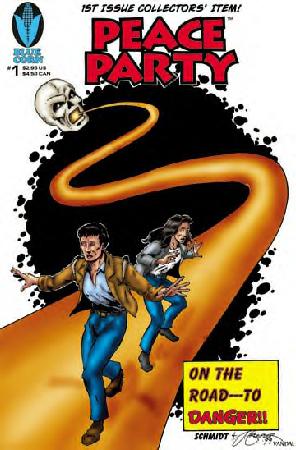|
|
Canku Ota |
|
|
(Many Paths) |
||
|
An Online Newsletter Celebrating Native America |
||
|
September 8, 2001 - Issue 44 |
||
|
|
||
|
Comic Book Images of American Indians Changing |
||
|
by University of Kansas Press Release |
||
|
Drawing Cover of Peace Party Issue One |
 LAWRENCE
-- Comic books have run the gamut of portraying the American Indian from subhuman to superhuman, according to Cornel
Pewewardy, University of Kansas assistant professor of education. LAWRENCE
-- Comic books have run the gamut of portraying the American Indian from subhuman to superhuman, according to Cornel
Pewewardy, University of Kansas assistant professor of education. Today's contemporary comic books include characters developed by American Indian cartoonists, who picture native people as more modern and with a futurist image, says Pewewardy. He will talk about American Indian images in comic books at 3 p.m. Thursday, Nov. 18, during an American Indian education conference at the Holidome in Lawrence. The conference is sponsored by the Kansas State Department of Education. Pewewardy's talk is titled "Native Children's Perceptions of Race and Class in the Media." "Each new popular culture generation has reinvented the Indian in the image of its own era," Pewewardy says. His study of comic book images appears in "American Indian Stereotypes in the World of Children," a recent book edited by Arlene Hirschfelder, Paulette F. Molin and Yvonne Wakim. In the past 90 years, the comics have gone from a gimmick to boost newspaper circulation to a cultural institution read daily by millions of Americans, Pewewardy says. During that time, American Indians have moved from being portrayed as servile noble savages to romanticized superheroes. "Understanding the contemporary images and perceptions of popular comic book images of American Indians is extremely important not only for Indian people, but also for the perception of mainstream cultures throughout the country, especially the Hollywood cultures that created the 'frontier myth' image of the Indian today." Today's comic books no longer treat ethnic characters as the butt of jokes, but with some important exceptions are portraying Indians and other ethnic characters positively and sensitively, Pewewardy says. "Superman, Captain Marvel and Batman, all of Anglo heritage, have been joined by Black Panther (African), White Tiger (Puerto Rican), Kitty Pryde (Jewish), Banshee (Irish), Colossus (Russian), Firebird (Mexican) and many more. ...American Indian characters continue to carry on with the 'back to the future' comic themes and traditions in a new comic book series called Tribal Force." "Students in America cannot truly understand the realities of contemporary American Indian lifestyles and worldview without understanding the popular Indian images of the past, present and of the future," Pewewardy says. Pewewardy, a Comanche-Kiowa, joined the KU faculty in 1996. He has taught at the elementary level and served as a principal for an Indian magnet school in St. Paul, Minn., and for schools on the Navajo Reservation in New Mexico. He earned a doctoral degree in education from Pennsylvania State University at University Park in 1989. |
|
|
||
|
|
||
| Canku Ota is a free Newsletter celebrating Native America, its traditions and accomplishments . We do not provide subscriber or visitor names to anyone. Some articles presented in Canku Ota may contain copyright material. We have received appropriate permissions for republishing any articles. Material appearing here is distributed without profit or monetary gain to those who have expressed an interest. This is in accordance with Title 17 U.S.C. section 107. | ||
|
Canku Ota is a copyright © 2000, 2001 of Vicki Lockard and Paul Barry. |
||
|
|
|
|
|
The "Canku Ota - A Newsletter Celebrating Native America" web site and its design is the |
||
|
Copyright © 1999, 2000, 2001 of Paul C. Barry. |
||
|
All Rights Reserved. |
||
